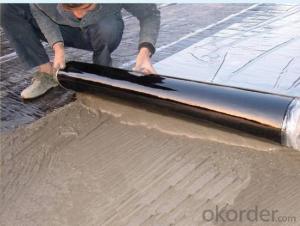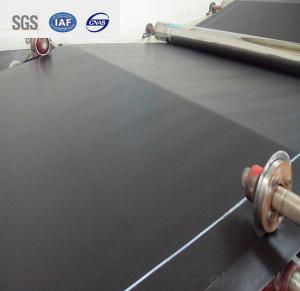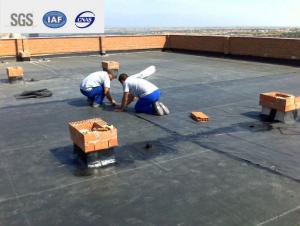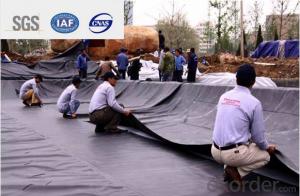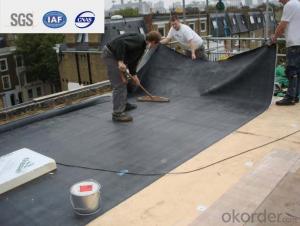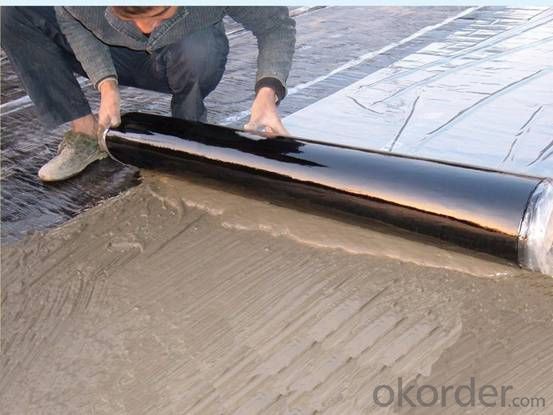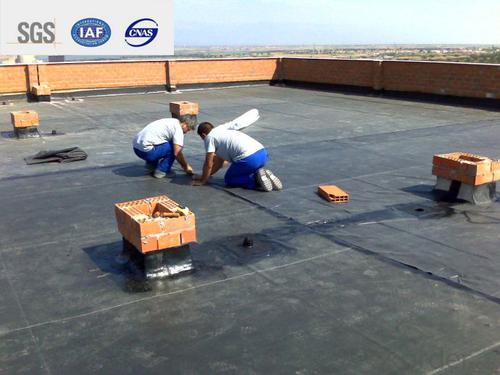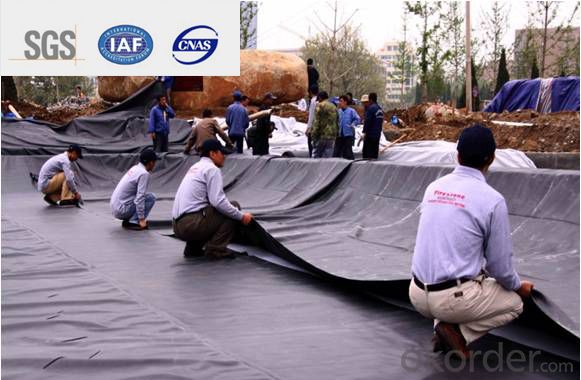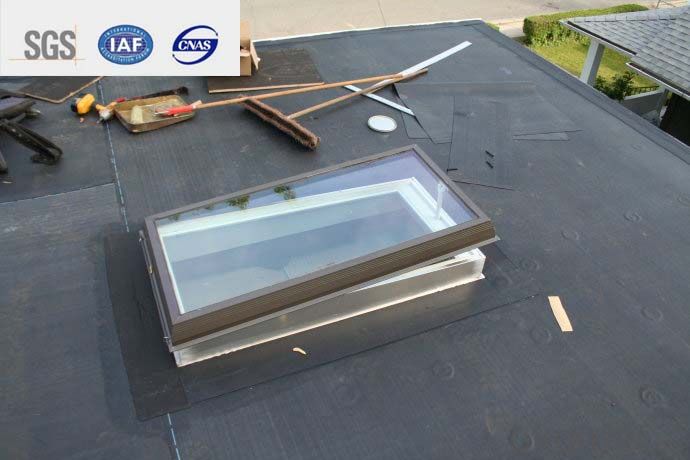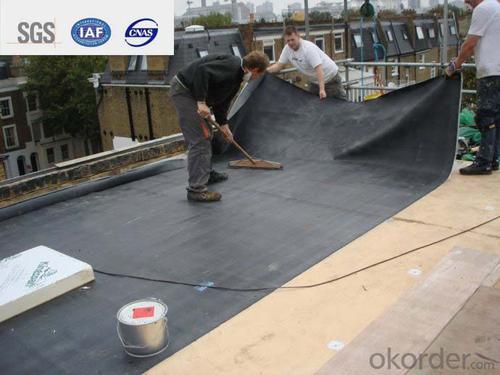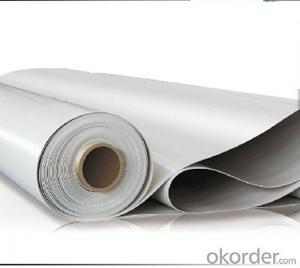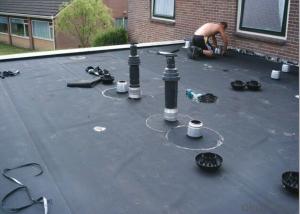EPDM Self-adhesive Waterproof Membrane for Rooftop Rubber Foam CMAX
- Loading Port:
- Qingdao
- Payment Terms:
- TT or LC
- Min Order Qty:
- 2000 m²
- Supply Capability:
- 800000 m²/month
OKorder Service Pledge
OKorder Financial Service
You Might Also Like
Description Of EPDM Self-adhesive Waterproof Membrane for Rooftop Rubber Foam :
Self adhesive waterproof rolling material:
thickness:1.2/1.5/2.0mm
length/roll:10/20m
width/roll:1.02m
Low temperature:-15 -20,-30
Main Features of EPDM Self-adhesive Waterproof Membrane for Rooftop Rubber Foam :
1) High tear
2) High puncturing strength
3) Great temperature resistance.
4) High dimensional stability
Specifications of EPDM Self-adhesive Waterproof Membrane for Rooftop Rubber Foam :
Material | EPDM Self-adhesive Waterproof Membrane |
Size | 1.2m (width)*20m (length) or customized, weldable type 2.05m or 4m width |
Thick | 1.2mm, 1.5mm, 2.0mm |
Type | Vulcanized & Weldable |
Pattern | Non-reinforced (homogeneous) |
Certificate | ISO9001/14001 |
Applications of EPDM Rubber Waterproof Membrane:
1.It is widely used in civil and industry construction.
2.The waterproof,dampproof of the roofs,basements,toilets etc;
3.And the waterproofing of subway,underground,bridges,car parking,tunnels,reserviors,pool etc.
4.SBS modified bitumen waterproof membrane is specially suitable to the building waterproofing in cold area and to the buildings of changeable constructions
5.APP specially suitable to areas of high temperature and of strong sunshine.
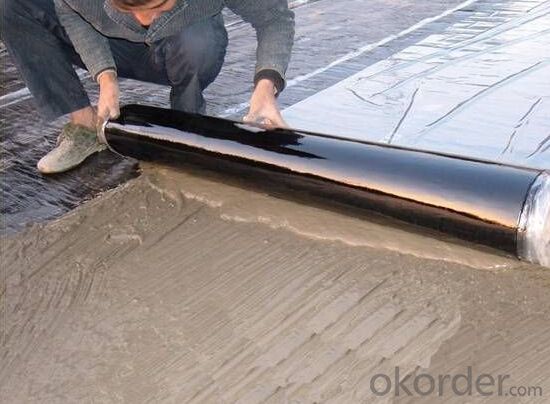


FAQ:
1. What are we supplying?
We are specialized in producing Colorful Asphalt Roof Shingle, SBS/APP modified bitumen waterproof membrane, Self adhesive bitumen waterproof membrane, PVC waterproofing membrane, EPDM rubber roofing membrane, Single Component Polyurethane Waterproof Coating, and Spray Polyurea Waterproof Coating.
2. How Many years experience do we have?
We have been exported to more than 20 countries in the past 15 years.
3. How long do we usually reply your request?
We always reply our customer within 24 hours.
- Q: Is a waterproofing membrane resistant to algae or moss growth?
- A waterproofing membrane is usually resistant to the growth of algae or moss. Its purpose is to form a barrier against water infiltration, preventing moisture from seeping into the underlying structure. These membranes are typically composed of materials that are not favorable for the growth of algae or moss, such as synthetic polymers or rubberized compounds. Furthermore, they are often treated with additives that hinder the growth of organic matter, including algae or moss. Nevertheless, it is crucial to acknowledge that if the membrane is consistently exposed to moisture or damp conditions over time, it may become a breeding ground for algae or moss. Therefore, it is important to regularly maintain and clean the waterproofing membrane to ensure its longevity and effectiveness.
- Q: Can a waterproofing membrane be used on plywood?
- Plywood, a commonly used material in construction, is often employed as a subfloor or as a foundation for different types of flooring. However, it lacks natural waterproofing properties and is vulnerable to moisture-related damage. To safeguard plywood from water harm, the application of a waterproofing membrane is recommended. These membranes serve as barriers, preventing water from infiltrating the plywood and thereby keeping it dry while deterring the growth of rot or mold. Waterproofing membranes find utility in various settings including bathrooms, kitchens, decks, and roofs. It is essential to select a suitable membrane for plywood and adhere to the manufacturer's instructions for proper installation in order to achieve optimal outcomes.
- Q: Is a waterproofing membrane resistant to cracking or shrinking?
- Typically, a waterproofing membrane resists cracking and shrinking. Its purpose lies in creating a barrier that prevents water from penetrating surfaces like roofs, walls, or foundations. To accomplish this, these membranes are typically constructed from flexible and durable materials, such as modified bitumen, PVC, EPDM, or polyurethane. These materials possess inherent properties that enable them to withstand different environmental conditions, including temperature fluctuations, UV radiation, and physical stresses. This resilience guarantees that the waterproofing membrane remains intact and stable, even when exposed to challenging circumstances. Furthermore, waterproofing membranes are engineered to be highly resistant against cracking and shrinking. They are designed to accommodate movements and structural changes that may arise in the building or substrate over time. This flexibility helps prevent the membrane from cracking or tearing, even in the presence of minor shifts or settling in the structure. Additionally, waterproofing membranes undergo rigorous testing and quality control measures during their manufacturing process. These tests replicate real-world conditions, including temperature changes, elongation, and compression, to verify the membrane's performance and durability. Nevertheless, it is vital to note that the quality and performance of a waterproofing membrane can vary depending on the specific product and manufacturer. Selecting a reliable and reputable brand, as well as ensuring proper installation and maintenance, is crucial to maximize the membrane's resistance to cracking or shrinking.
- Q: Are waterproofing membranes flexible?
- Yes, waterproofing membranes are typically flexible. They are designed to be able to expand and contract with the building materials they are applied to, ensuring a tight and secure seal to prevent water penetration.
- Q: Can a waterproofing membrane be used on tunnels with fire protection systems?
- Tunnels equipped with fire protection systems can indeed make use of a waterproofing membrane. It is actually quite common to recommend the use of a waterproofing membrane alongside fire protection systems in tunnels, as it adds an extra layer of safeguarding. The purpose of this membrane is to prevent any water from infiltrating the tunnel, as this could potentially harm the fire protection systems and undermine their effectiveness. By ensuring the tunnel remains watertight, the waterproofing membrane preserves the integrity and functionality of the fire protection systems, enabling them to fulfill their intended purpose in the event of a fire. Moreover, the waterproofing membrane can also serve as a barrier, impeding the spread of fire by blocking the passage of flames and smoke. Nonetheless, it is crucial to ensure that the chosen waterproofing membrane is compatible with the specific fire protection systems employed in the tunnel in order to ensure optimum performance and safety.
- Q: Can a waterproofing membrane be used for potable water tanks?
- No, a waterproofing membrane should not be used for potable water tanks. While a waterproofing membrane is designed to prevent water penetration and protect surfaces from moisture damage, it is not suitable for ensuring the safety and purity of potable water. Potable water tanks require materials that are specifically designed and approved for water storage, such as food-grade coatings or liners. These materials are formulated to prevent any leaching or contamination of the water, ensuring its safety for consumption. Therefore, it is important to use the appropriate materials and follow industry standards and regulations when constructing potable water tanks.
- Q: Are there any specific installation techniques for corners and edges when using a waterproofing membrane?
- Yes, there are specific installation techniques for corners and edges when using a waterproofing membrane. These techniques are important to ensure that the corners and edges are properly sealed and protected from water infiltration. For corners, it is recommended to use corner flashings or preformed corner pieces specifically designed for waterproofing applications. These corner flashings or preformed pieces are typically made of flexible materials such as rubber or PVC and are installed over the membrane to provide a watertight seal. They should be securely fastened to the substrate and overlapped with the membrane to create a continuous barrier against water. When it comes to edges, it is crucial to install edge flashings to prevent water from seeping underneath the membrane. Edge flashings are installed along the perimeter of the waterproofing membrane and are typically made of the same material as the membrane itself. They should be properly sealed and securely fastened to the substrate to ensure a tight and reliable seal. Additionally, it is important to properly overlap the membrane at corners and edges to create a seamless and continuous barrier against water. The manufacturer's instructions should be followed carefully to ensure the correct overlap width and method. Generally, a minimum overlap of at least 2 inches is recommended for corners and edges. Overall, the specific installation techniques for corners and edges when using a waterproofing membrane involve the use of corner and edge flashings, proper sealing and fastening, and correct overlap of the membrane. Following these techniques will help to ensure a reliable and effective waterproofing system.
- Q: Can a waterproofing membrane be used in conjunction with warranty or insurance policies?
- Yes, a waterproofing membrane can typically be used in conjunction with warranty or insurance policies. Many waterproofing products and systems come with warranties that provide coverage for a certain period of time, typically ranging from 5 to 20 years or more. These warranties often guarantee the effectiveness and durability of the waterproofing membrane, and may cover repairs or replacements in case of any failures or defects. Additionally, insurance policies may also provide coverage for damages caused by water leaks or flooding. By installing a waterproofing membrane, property owners can mitigate the risk of water damage and potentially reduce their insurance premiums. It is advisable to check with your insurance provider to determine if they offer any discounts or incentives for using waterproofing systems. However, it is important to note that the coverage provided by warranties and insurance policies may vary depending on the specific terms and conditions. It is recommended to carefully review the details of the warranty or insurance policy and consult with professionals to ensure that the waterproofing membrane meets the requirements and specifications outlined by these agreements.
- Q: The difference between waterproof linoleum and waterproofing membrane
- Waterproof membrane is mainly used for building walls, roofs, as well as tunnels, highways, landfills, etc., to resist the external rain, groundwater leakage can be curled into a roll of flexible building materials, as the basis for engineering And no leakage between the building connection, the entire project is the first waterproof barrier, the entire project plays a vital role. The main products are asphalt waterproofing membrane and polymer waterproofing membrane.
- Q: Can waterproofing membranes be used on roofs?
- Roofs can indeed benefit from the application of waterproofing membranes. These membranes serve the purpose of establishing a protective barrier that thwarts water infiltration. In order to accomplish this, the membranes are carefully crafted using materials such as modified bitumen, EPDM, PVC, or TPO, all of which boast remarkable water resistance capabilities and are proficient at sealing roofs. Their usage spans across various settings, including residential and commercial environments, where they prove to be invaluable for flat roofs, low-slope roofs, and even specific sloped roof designs. Employing multiple layers of waterproofing membranes ensures optimal safeguarding against water-related harm and significantly prolongs the roof's lifespan by averting leaks and moisture accumulation.
Send your message to us
EPDM Self-adhesive Waterproof Membrane for Rooftop Rubber Foam CMAX
- Loading Port:
- Qingdao
- Payment Terms:
- TT or LC
- Min Order Qty:
- 2000 m²
- Supply Capability:
- 800000 m²/month
OKorder Service Pledge
OKorder Financial Service
Similar products
Hot products
Hot Searches
Related keywords
